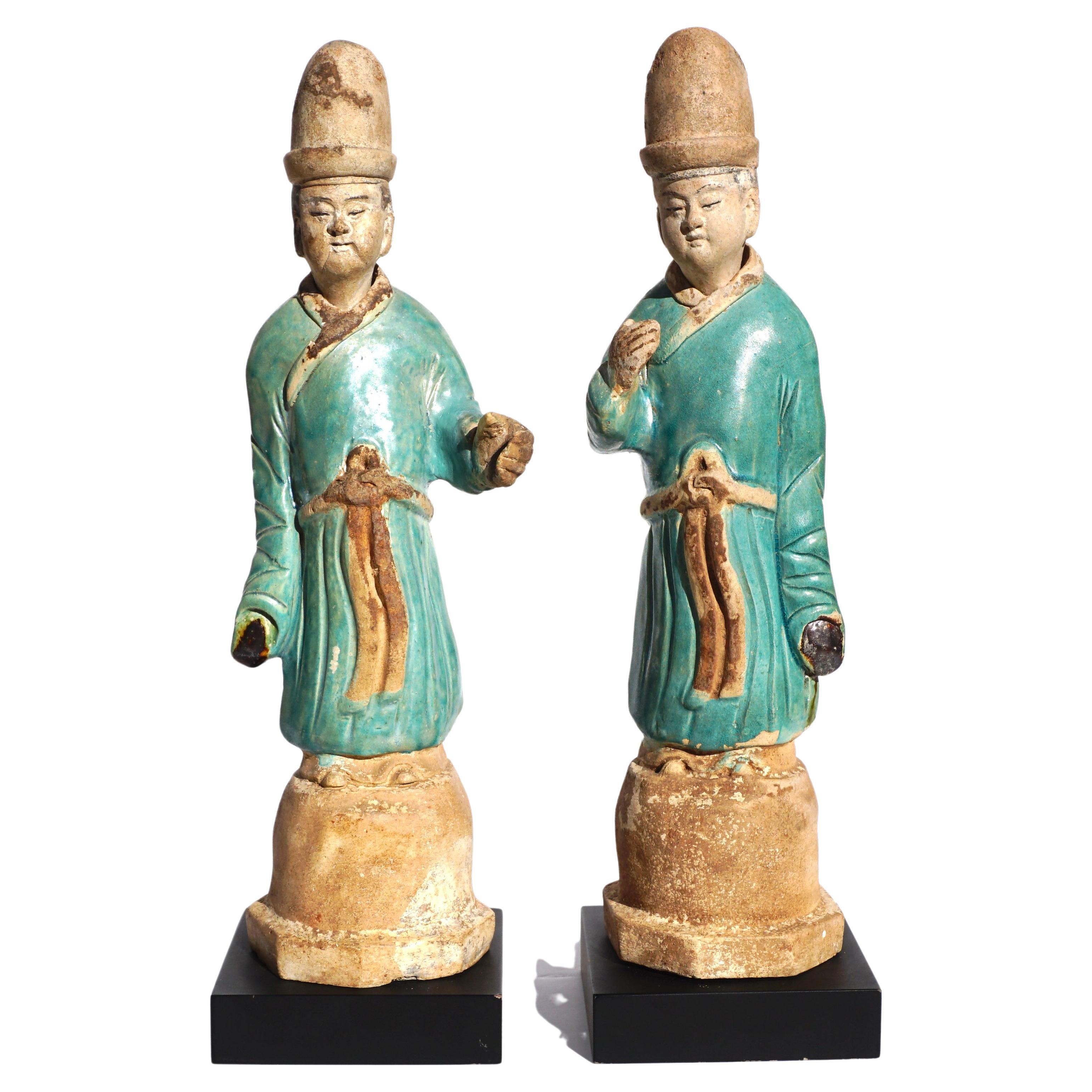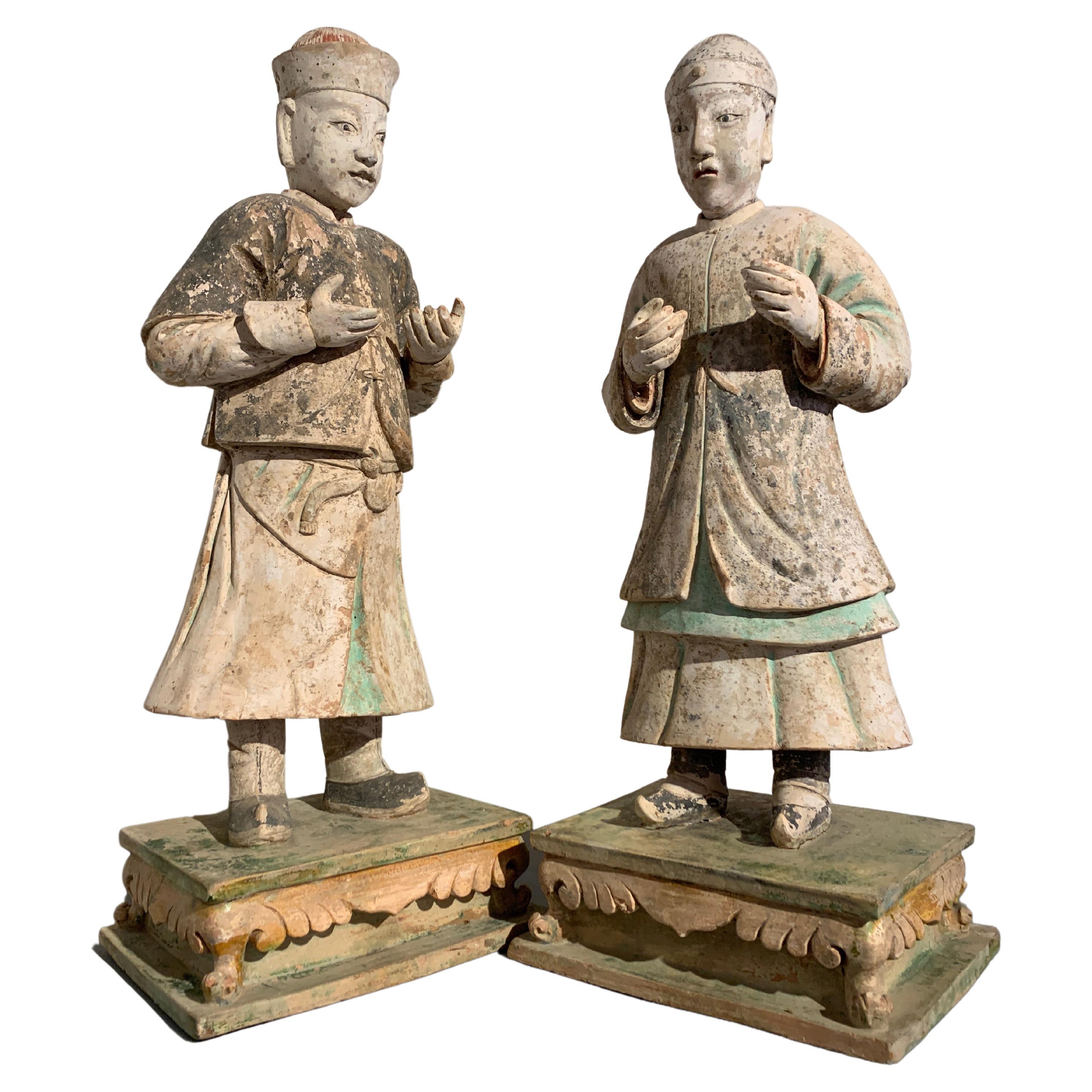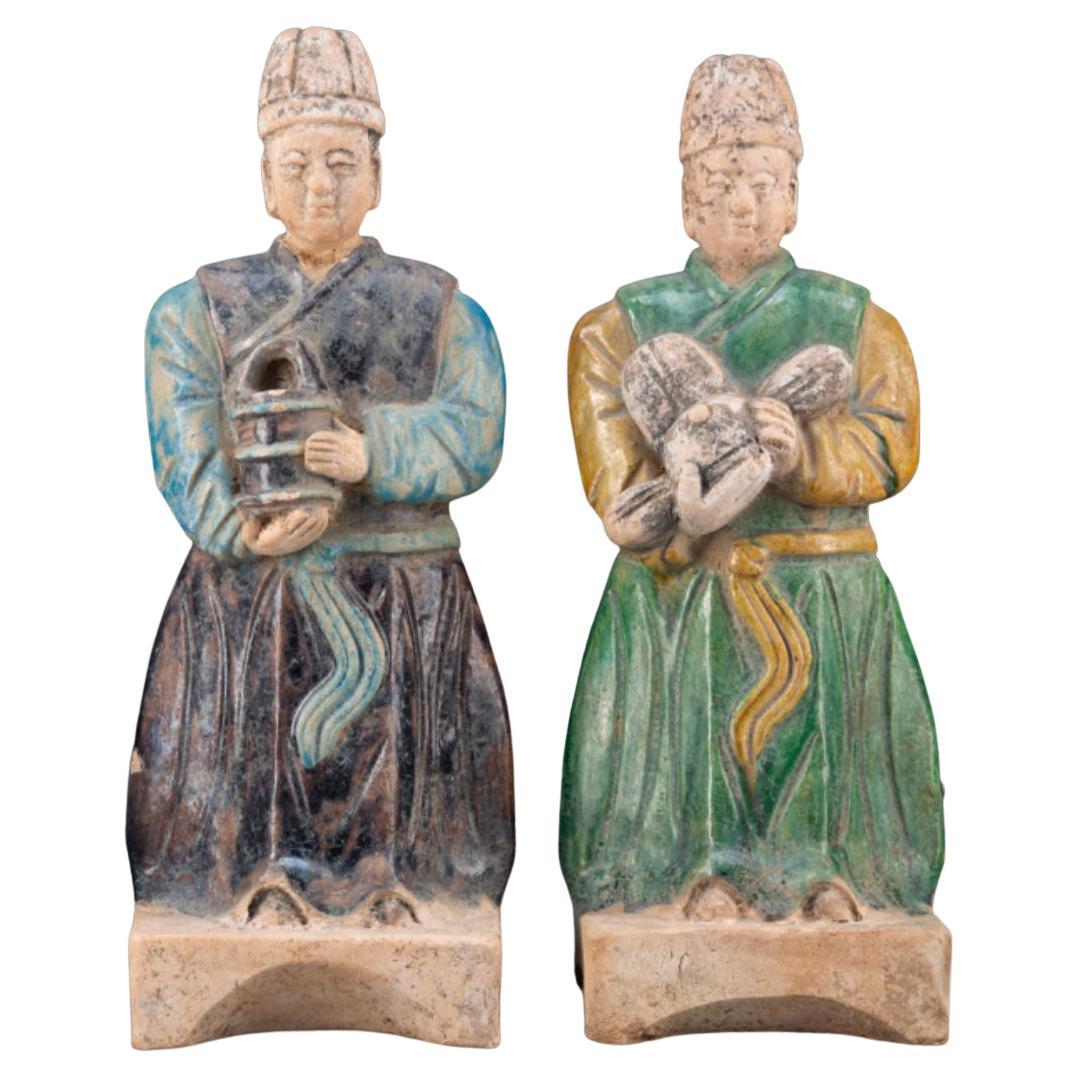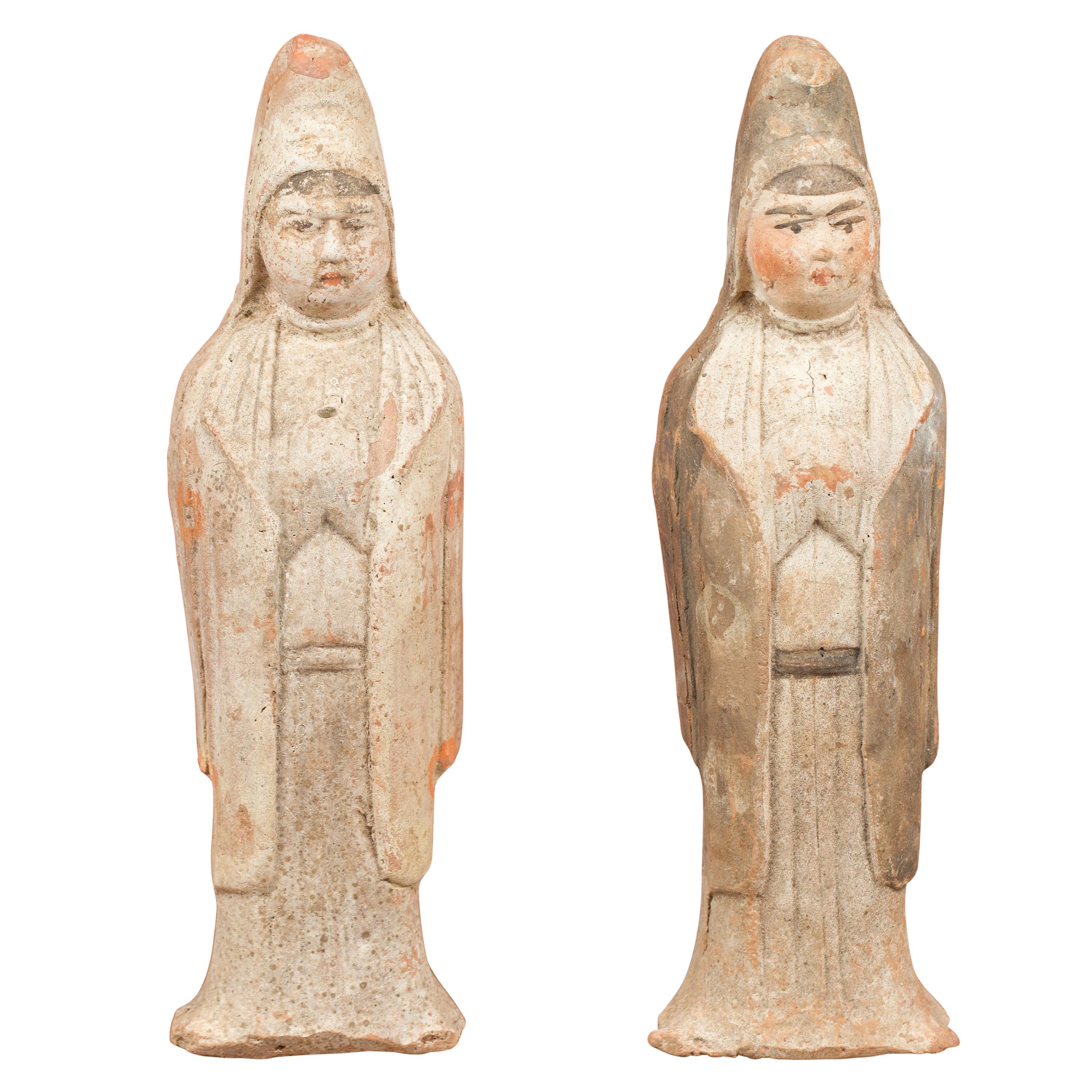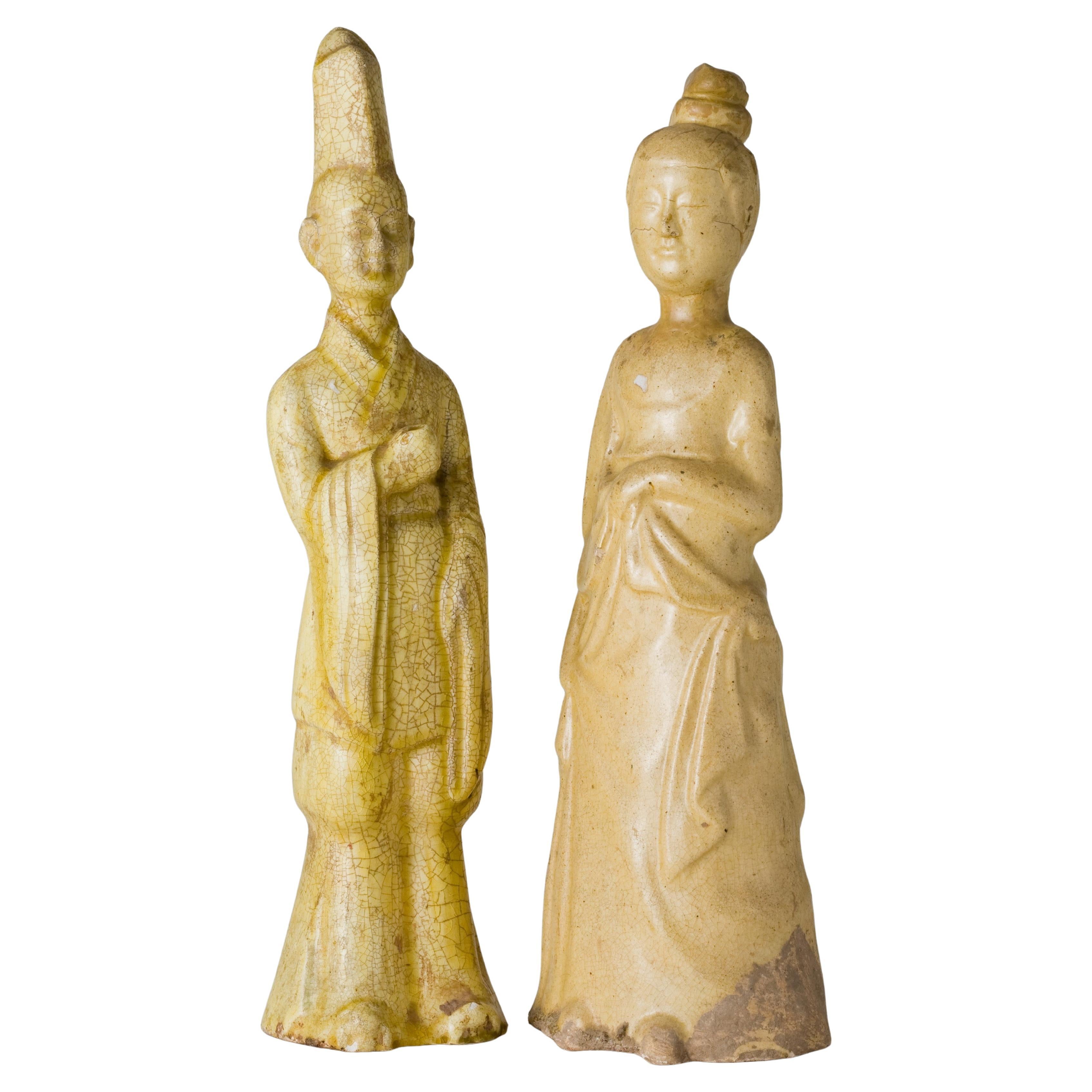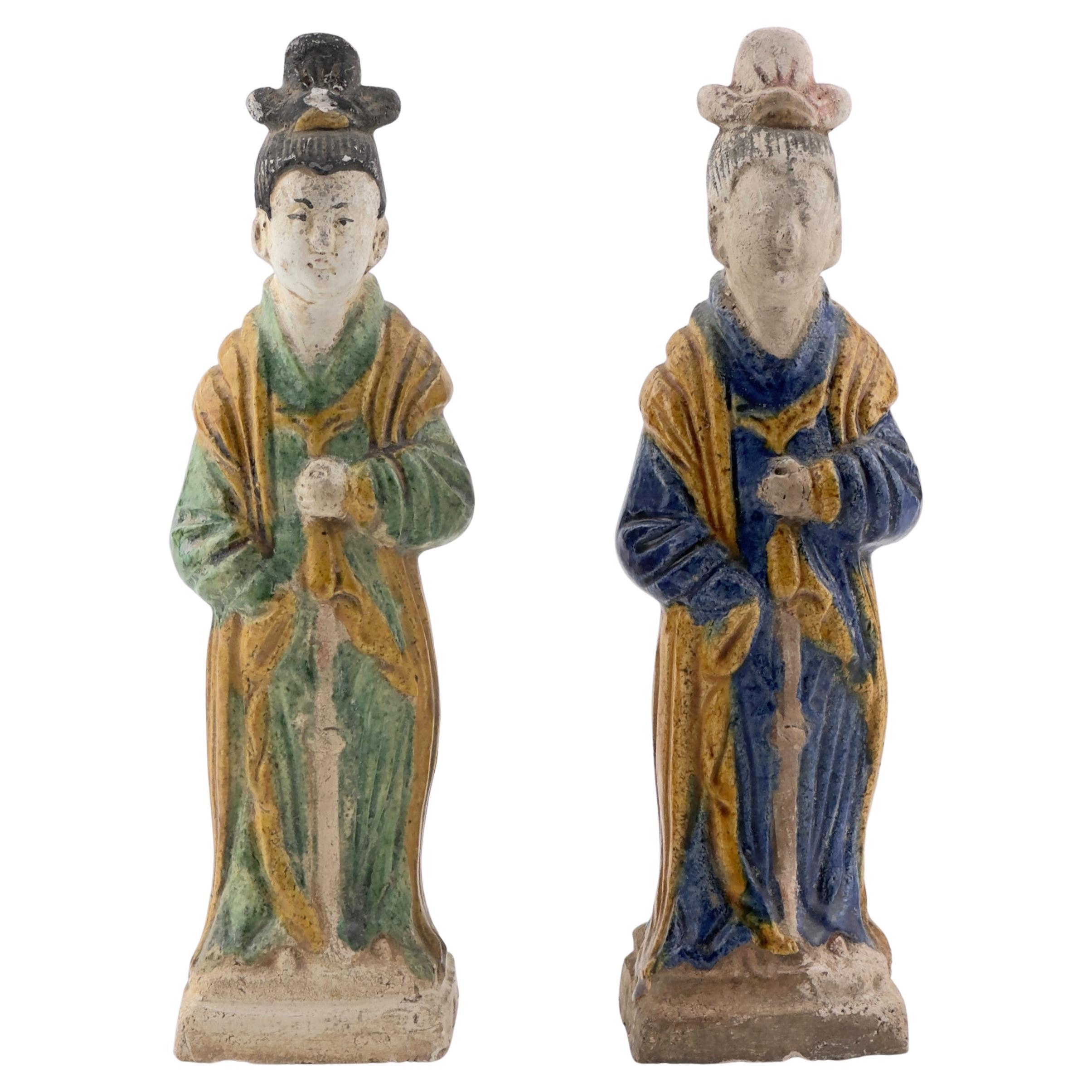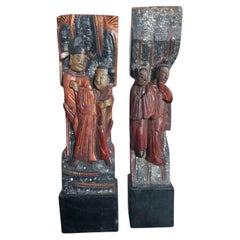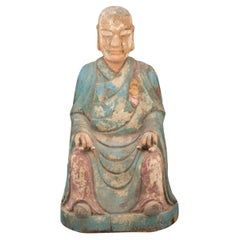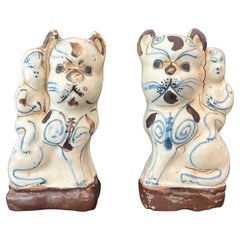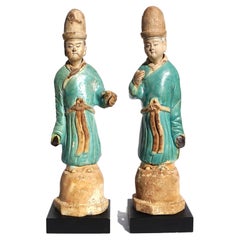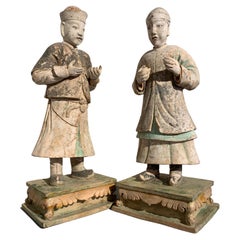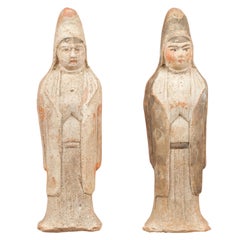Items Similar to Chinese Ming Dynasty Antique Sancai Glazed Attendants Tomb Figure Pair
Want more images or videos?
Request additional images or videos from the seller
1 of 12
Chinese Ming Dynasty Antique Sancai Glazed Attendants Tomb Figure Pair
$2,500per set
£1,919.76per set
€2,202.27per set
CA$3,512.79per set
A$3,934.11per set
CHF 2,052.75per set
MX$48,053.42per set
NOK 26,116.99per set
SEK 24,618.39per set
DKK 16,435.25per set
About the Item
A pair of large antique Chinese polychrome ceramic attendants, Ming Dynasty (1368-1644).
Outstanding 500+ year old Sancai glazed earthenware pottery tomb figures, exceptionally executed figural form, exquisitely detailed, one holding a teapot, the other holding a charger, rising on rare sculptural plinth base with concave side details.
Dimensions: (approx)
13.25" Tall, 5" Wide, 4.5" Deep (each)
Condition Report:
Superb museum quality examples, in excellent original unrestored antique condition. Present well. Desirable crazing to glaze. Rubbing to polychrome details on heads of both, surface wear on both commensurate with age, handling, and exposure.
About Ming Tomb figures:
Tomb figures, also known as mingqi, were funerary objects placed in tombs during the Ming Dynasty (1368-1644) in China. These figures were made of clay, wood, or bronze, and were intended to provide the deceased with companionship, entertainment, and protection in the afterlife. They included statues of people, animals, and mythical creatures, as well as models of houses, furniture, and other objects. These figures were typically painted or glazed, and were often buried with the deceased in their tombs. The production of mingqi was a significant industry during the Ming Dynasty, and many skilled artisans were employed to create these objects.
The number of tomb figures, or mingqi, placed in a Ming Dynasty (1368-1644) tomb varied depending on the wealth and status of the individual being buried. Elite tombs, such as those of emperors and high-ranking officials, could have hundreds or even thousands of mingqi, while the tombs of commoners might have only a few.
The quantity of mingqi sculpture in a tomb also varied depending on the time period and location. For example, tombs from the early Ming period (1368-1425) were typically larger and contained more mingqi than those from the late Ming period (1550-1644) which were smaller. Additionally, tombs from the southern regions of China tended to have more mingqi than those from the north.
In general, it is believed that the purpose of the mingqi was not only to provide the deceased with companionship, entertainment, and protection in the afterlife, but also to demonstrate the wealth and status of the individual during their lifetime.
The size of Ming Dynasty tomb figures, or mingqi, varied depending on the type of object and the wealth and status of the individual for whom it was made. Some of the largest mingqi were statues of people and animals, which were typically several feet tall.
For example, the largest known Ming tomb figure is a clay statue of a horse, which is over 3 meters tall and 4 meters long, and was discovered in the tomb of the Yongle Emperor, who ruled from 1403 to 1424. Other large mingqi include statues of warriors, officials, and guardians, which are typically several feet tall. Additionally, there are large pottery figures of military units, musicians, and even a complete kitchen with all the utensils, which were also intended to serve the deceased in the afterlife.
It's worth noting that many of these large figures have been discovered in tombs of emperors and high-ranking officials, indicating that they were commissioned by those who could afford it and were intended to demonstrate their wealth and status even in the afterlife.
- Dimensions:Height: 13.25 in (33.66 cm)Width: 5 in (12.7 cm)Depth: 4.5 in (11.43 cm)
- Sold As:Set of 2
- Style:Ming (Of the Period)
- Materials and Techniques:
- Place of Origin:
- Period:
- Date of Manufacture:circa 1400s/1500s
- Condition:Wear consistent with age and use. Superb museum quality examples, in excellent original unrestored antique condition. Present well. Desirable crazing to glaze. Rubbing to polychrome details on heads of both, surface wear on both commensurate with age, handling, and exposure.
- Seller Location:Forney, TX
- Reference Number:1stDibs: LU5977236246462
About the Seller
4.8
Platinum Seller
Premium sellers with a 4.7+ rating and 24-hour response times
Established in 2013
1stDibs seller since 2021
294 sales on 1stDibs
Typical response time: <1 hour
- ShippingRetrieving quote...Shipping from: Forney, TX
- Return Policy
Authenticity Guarantee
In the unlikely event there’s an issue with an item’s authenticity, contact us within 1 year for a full refund. DetailsMoney-Back Guarantee
If your item is not as described, is damaged in transit, or does not arrive, contact us within 7 days for a full refund. Details24-Hour Cancellation
You have a 24-hour grace period in which to reconsider your purchase, with no questions asked.Vetted Professional Sellers
Our world-class sellers must adhere to strict standards for service and quality, maintaining the integrity of our listings.Price-Match Guarantee
If you find that a seller listed the same item for a lower price elsewhere, we’ll match it.Trusted Global Delivery
Our best-in-class carrier network provides specialized shipping options worldwide, including custom delivery.More From This Seller
View AllPair of Qing Dynasty Chinese Religious Temple Architectural Ornament
Located in Forney, TX
A scarce pair of Qing Dynasty temple architectural ornaments, the decorative antique building element fragments each elaborately hand carved, polychrome painted and lacquered, richly detailed featuring two figural pairs accented...
Category
Antique Early 19th Century Asian Folk Art Architectural Elements
Materials
Mother-of-Pearl, Wood, Lacquer, Paint
Antique Korean Carved Polychrome Wooden Buddhist Figure Sculpture
Located in Forney, TX
Bring a touch of peaceful tranquil serenity and help ward off sickness and negative energy with this large Joseon dynasty (1392–1910) antique Asian hand carved and painted wood Buddh...
Category
Antique 19th Century Korean Folk Art Sculptures and Carvings
Materials
Wood
Pair of Antique Chinese Glazed Figural Censers
Located in Forney, TX
A pair of antique Cizhou-type cream glazed cat (mao) incense stick holders.
Dating to the early Qing - possibly late Ming Dynasty, scarce near...
Category
Antique 18th Century Chinese Ceramics
Materials
Porcelain
$1,100 / set
Pair of Vintage Chinese Figural Architectural Element Incense Burner Stand
Located in Forney, TX
A wonderful pair of antique Chinese red lacquer and gilt gold painted hand carved wooden figural architectural elements turned incense burner pillars. Highly detailed carvings featuring Asian pine tree motif representing longevity, horseback rider believed warrior Guan Yu...
Category
Early 20th Century Asian Sculptures and Carvings
Materials
Wood, Paint
Rare Set of Two Qing Dynasty Chinese Architectural Temple Brackets
Located in Forney, TX
An original matched pair of exceptionally carved Chinese temple architectural ornaments, the ornate decorative brackets salvaged from an early Qing Dynasty temple, the richy detailed...
Category
Antique Early 19th Century Asian Folk Art Architectural Elements
Materials
Wood, Lacquer, Paint
19th Century Chinese Temple Architectural Corbel Carved Sculpture Pair
Located in Forney, TX
A majestic pair of antique architectural salvaged Chinese temple corbels, now mounted as one-of-a-kind wooden sculptures on custom floor standing display pedestal stands.
Originally commissioned for an important religious temple in China, the impressive large scale wall bracket corbels were notoriously difficult as they had to serve as both highly decorative temple ornaments and structural building elements used to support the weight of a wall.
Hand-crafted in the early 19th century, smilarly styled design, each exceptionally hand carved, sculpted, and painted by highly trained artisans. Profusely carved and decorated, featuring very fine quality high relief work throughout, extensive bas relief, pierced openwork, rich carvings and intricate incised detailing, depicting various Chinese folk religion figures and imagery.
Rising on bespoke handmade stands, consistenting of sturdy rectangular shaped thick plank plinth base embellished with foliate carvings, held upright by turned column single support.
Rich in culture and history, interesting, unusual, highly decorative, whimsical and artistic, sure to add sophisticated elegance, rustic character, color, space, texture and lots of visual interest.
Dimensions, largest (approx):
Each: 32.5" H, 19" W, 7.25" D.
Please note, the objects were sourced and transported both legally and ethically, retaining partial original red wax export seal to top.
Display the three Sanxing, in their iconic representation as three, old, bearded, wise men, which dates back to the Ming dynasty, when the Gods of the three stars were represented in human form for the first time. One panel having two monumental smiling figures with hand painted eyes and tongue, the other fragment depicting four figures, seated and standing, likely Immortals, Gods, Shen deity, and other characters from ancient Chinese mythology and folklore. Both pieces with elaborate lotus and pine tree motif, a powerful symbol of wisdom and longevity.
Sanxing figures are an important part of Asian culture. Statues of these three Gods...
Category
Antique 19th Century Chinese Chinese Export Architectural Elements
Materials
Wood, Paint
You May Also Like
Pair Ming Dynasty Glazed Pottery Dignitary Figures
Located in Dallas, TX
A pair of Ming dynasty sancai blue glazed pottery figures.
Circa 1500 AD Ming Dynasty
I have owned over 250 ming tomb figures including over 80...
Category
Antique 16th Century Chinese Ming Figurative Sculptures
Materials
Pottery
Pair Large Chinese Ming Dynasty Glazed and Painted Pottery Figures, 16th Century
Located in Austin, TX
A striking pair of large Chinese glazed and painted pottery figures, Ming Dynasty (1368 to 1644), circa 16th century, China.
The impressive and realistically modeled figures each portrayed standing upright upon a sancai (three color) glazed pedestal of kang table form.
The man is dressed in a short black surcoat over a long robe and pants, a smart cap upon his head. His face is warm and welcoming, with wide eyes and a slight smile on his lips. He holds his hands out in front of him, palms up, almost as if shrugging, though presumably originally holding an object or offering, now lost.
The woman of slightly smaller stature, and dressed in a longer surcoat over a long robe and skirt. She wears a fitted cap upon her head. Her hands also held out in front, grasping long lost objects. Her face is slightly more severe, with a somewhat pinched look, and slight frown upon her lips.
The size of these figures is remarkable, as is the realism and attention to detail, almost as if they were modeled after real people, as opposed to the more common and generic Ming Dynasty pottery...
Category
Antique 16th Century Chinese Ming Sculptures and Carvings
Materials
Pottery
Chinese Ming Dynasty Glazed Pottery Attendants
Located in Dallas, TX
A pair of Chinese Ming Dynasty glazed earthenware figure of Attendant
The condition of these 5 century old glazed pottery tomb figures is outstand...
Category
Antique 16th Century Chinese Ming Figurative Sculptures
Materials
Pottery
Pair of Qing Dynasty Early 20th Century Small Hand Painted Terracotta Statues
Located in Yonkers, NY
A pair of Qing dynasty 20th century terracotta Chinese hooded priestess sculptures with original paint. Discover the exquisite charm of this pair of 20th century Qing dynasty terraco...
Category
Early 20th Century Chinese Qing Sculptures and Carvings
Materials
Terracotta
Two Straw-Glazed Pottery Figures of Court Male and Female, Sui-Tang dynasty
Located in seoul, KR
This pair of straw-glazed pottery figures represents a male and female court attendant, both elegantly attired in period fashion. The female figure wears a flowing robe with draped f...
Category
Antique 15th Century and Earlier Hong Kong Tang Antiquities
Materials
Pottery, Straw
$1,400 Sale Price / set
30% Off
Two Glazed Court Attendants, Ming Period (1368-1644)
Located in seoul, KR
Two finely hollow-moulded terracotta statuettes from ancient China, dating to the Ming Dynasty. The figure is depicted standing, dressed in long, flowing robes, painted in vibrant blue or green and deep amber yellow. The hair is styled into an elaborate top-knot, painted in a muted brown. Areas left unpainted would have been 'cold-painted' after firing, contrasting with the vivid fired blue or green and amber pigments. The figure is shown with the left hand raised to the chest, as if holding something, possibly an offering or incense. Figurines like this were placed in tombs to guide the deceased on their journey to the afterlife.
The Ming Dynasty was known for its exceptional artistic achievements, partly due to its economic prosperity. Since the Han Dynasty, it was customary to bury terracotta miniatures of everyday objects with the deceased. These items, known as mingqi, or "spirit utensils" and "vessels for ghosts," were believed to help and assist the deceased in the afterlife. Mingqi were crafted in the form of cooking utensils, miniature replicas of houses, temples, furniture, and other items. Anthropomorphic and zoomorphic terracotta figures were also popular, designed to assist, entertain, and recreate the living world for the deceased.
Period: Ming Dynasty
Medium: Green/blue-glazed Pottery
Type: Figure
Provenance : Acquired in late 1990s from Hongkong
Reference :
1) Ancient & Oriental - Terracotta Tomb Attendants
(Type : Highly related)
2) La Maison De La Petite Sara S.r.l. - Archaeology section - A Black glazed Terracotta Statuette, Servant with Trumpet, Ming Dynasty
(Price realised : 700 GBP / Type : Highly related)
* Ming Dynasty Glazed Pottery Figures
Ming Dynasty glazed pottery figures are renowned for their bold color palette, intricate detailing, and lifelike forms, distinguishing them from earlier traditions. These figures, which depict officials, warriors, animals, and mythical creatures, are characterized by high-gloss lead-based glazes in green, amber, ochre, and sancai (three-color) combinations. The thickly applied glaze pools in recesses, creating depth and enhancing sculptural details. With dynamic postures, expressive facial features, and meticulously rendered drapery, these figures reflect the period’s advancement in ceramic craftsmanship, offering a greater sense of movement and realism compared to the rigid and stylized forms of earlier dynasties.
A defining characteristic of Ming glazed pottery is its elaborate surface detailing, often achieved through raised relief elements and contrasting glazes. Equestrian figures, for example, feature carefully sculpted saddles, harnesses, and decorative embellishments, while human figures are adorned with intricate robes and headdresses. The large scale of these tomb figures, often more imposing than those from previous periods, underscores the increasing importance of funerary art during the Ming era. Unlike later Qing Dynasty figures...
Category
Antique 15th Century and Earlier Hong Kong Ming Antiquities
Materials
Pottery
$1,943 Sale Price / set
35% Off
More Ways To Browse
Earthenware Antique Glazed
Antique Chinese Earthenware
1500s Furniture
Chinese Tomb
Ceramic Plinths
Chinese Warrior
Ming Chinese Figures
Chinese Pottery Figure
Polychrome Charger
Ming Dynasty Sculpture
Horse Wood Carving
Ming Figure
Large Chinese Charger
Old Utensils
Chinese Warrior Sculpture
Antique Pottery Teapots
15th Century Wood Carving
Sculpture Teapot
